Phoenician
Tyre
was
queen
of
the
seas,
an
island
city
of
unprecedented
splendor.
She
grew
wealthy
from
her
far-reaching
colonies
and
her
industries
of
purple-dyed
textiles.
But
she
also
attracted
the
attention
of
jealous
conquerors
among
them
the
Babylonian
King
Nebuchadnezzar
and
Alexander
the
Great.
Five
Millennia
of
History
Founded
at
the
start
of
the
third
millennium
B.C.,
Tyre
originally
consisted
of
a
mainland
settlement
and
a
modest
island
city
that
lay
a
short
distance
off
shore.
But
it
was
not
until
the
first
millennium
B.C.
that
the
city
experienced
its
golden
age.
In
the
10th
century
B.C.
Hiram,
King
of
Tyre,
joined
two
islets
by
landfill.
Later
he
extended
the
city
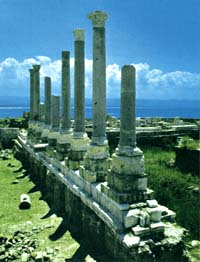
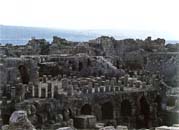
The public baths
The Romans built great important monuments in the city, including an aqueduct,
a triumphal arch and the largest hippodrome in antiquity.
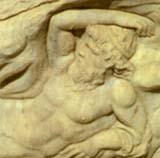 |
Christianity
figures
in
the
history
of
Tyre,
whose
name
is
mentioned
in
the
new
testament.
During
the
Byzantine
era,
the
Archbishop
of
Tyre
was
the
primate
of
all
the
bishops
of
Phoenicia. At this time the town witnessed a second golden age as can be seen from the remains of its buildings and the inscriptions in the necropolis. Taken by the Islamic armies in 634, the city offered no resistance and continued to prosper under its new rulers, exporting sugar as well as objects made of pearl and glass. |
|
|
With
the
decline
of
the
Abbasid
caliphate,
Tyre
acquired
some
independence
under
the
dynasty
of
Banu
'Aqil,
vassals
of
the
Egyptian
Fatimides.
This
was
a
time
when
Tyre
was
adorned
with
fountains
and
its
bazaars
were
full
of
all
kinds
of
merchandise,
including
carpets
and
jewerly
of
gold
and
silver. Thanks to Tyre's strong fortifications it was able to resist to onslaught of the Crusaders until 1124. After about 180 years of Crusader rule, the Mamlukes retook the city in 1291, then it passed on to the Ottomans at the start of the 16th century. With the end of the World War I Tyre was integrated into the new nation of Lebanon. |
||
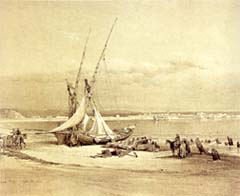 View of Tyre (19th century engraving) |
Archeological
Tyre For a period of nearly 50 years the General Directorate of Antiquities excavated in and around Tyre, concentrating on the three major Roman archaeological sites in the town, which can be seen today. The most important recent archaeological find in a Phoenician cemetery from the first millennium B.C. Discovered in 1991 during clandestine excavations, this is the first cemetery of its kind found in Lebanon. Funerary jars, inscribed steles and jewelry were among the objects retrieved |
|
| from the site. The importance of this historical city and its monuments was highlighted in 1979 when UNESCO declared Tyre a world Heritage Site. In the meantime, government efforts have stopped much of the wartime pillaging that Tyre's archaeological treasures have suffered because of economic stress in the area and international demand for antiquities. Grassroots campaigns have also drawn attention to the importance of the city's antiquities. | ||
| Back to top | ||
| V I S I T I N G T Y R E ' S A N C I E N T S I T E S | ||
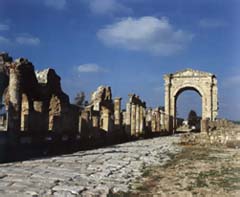 The Triumphal Arch |
Area
One,
located
on
what
was
the
Phoenician
island,
is
a
vast
district
of
civic
buildings,
colonnades,
public
baths,
mosaic
streets
and
a
rectangular
arena. Walk to the beach at the far end of the site. The columns to the left belong to a Palaestra, an area where athletes trained. Other excavated remains on this site date to the Hellenistic, Roman, and Byzantine periods. A short distance from the shore you will see "islands" which are, in fact, the great stone breakwaters and jetties of the ancient Phoenician port, called the "Egyptian port" because it faced south towards Egypt. |
|
Area
Two,
is
a
five
minute
walk
to
the
west.
Its
major
point
of
interest
is
a
Crusader
cathedral.
Only
the
lowest
foundations
and
a
few
re-erected
granite
columns
remain
intact
but
these
are
nevertheless
impressive.
The
area
below
has
revealed
a
network
of
Romano-Byzantine
roads
and
other
installations.
Visitors
are
not
allowed
inside
the
site,
but
the
ruins
can
be
viewed
from
the
road.
Area
Three,
is
a
thirty
minute
walk
from
Areas
One
and
Two
and
consists
of
an
extensive
necropolis,
a
three-bay
monumental
arch
and
one
of
the
largest
Roman
hippodrome
ever
found.
All
date
from
the
2nd
century
A.D.
to
the
6th
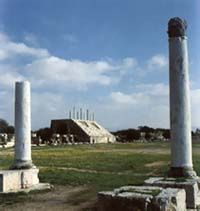
The hippodrome
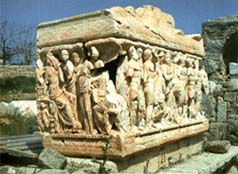 Marble sarcophagus 2nd century A.D. |
South
of
the
necropolis
is
the
partially
reconstructed
Roman
hippodrome excavated in 1967. The 480-meter structure seated twenty thousand spectators who gathered to watch the death-defying sport of chariot racing. Each end of the course was marked by still existing stone turning posts (metae). Charioteers had to make this circuit seven times. Rounding the metae at top speed was the most dangerous part of the race and often produced spectacular spills. |
|
| The walk to Area Three takes you through a residential part of Tyre called Hay Er-Raml or the Quarter of Sand. You are in fact walking on what once was Alexander the great causeway. Accumulating sands and extensive landfill have expanded this old land link to the extent that modern visitors have the impression that Tyre is built on a peninsula. | ||
|
Tyre
Today Tyre has a colorful souk (covered market) well worth exploring. Look for the Ottoman khan, or inn, just inside the market entrance. On a side street is the "Mamluke House", an Ottoman period residence that is being restored as a cultural heritage and information center by the General Directorate of Antiquities. Also in the souk area is a white, double-domed Shia mosque of great interest. Near the market you will |
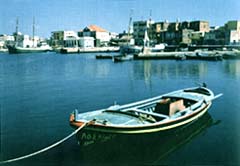 The port of Tyre |
|
| see a busy fisherman's port, in Phoenician times referred to as the "Sidonian" port because it faced north towards Sidon. Walk along the port with the sea on your right and you enter the city's Christian Quarter, a picturesque area of narrow streets, traditional architecture, and the Seat of the Maronite bishop of Tyre and the Holy land. One medieval tower still stands in a small garden. A second one is visible under the little lighthouse. During Crusader times towers similar to these ringed the city. | ||
|
Ameneties The archeological sites are open daily. Several seafood restaurants and pubs are located in the port area and fast food places have opened in the Hay Er-Raml area. Local restaurants fare is good. The seaside Elissa Hotel is the hotel in Tyre and is located near the |
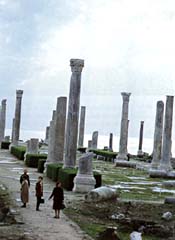 Roman period street bordered by columned porticoes |
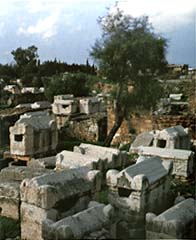 The Necropolis |
If
You
have
Time
Skin
Diving:
Basic
equipment
is
sufficient
for
exploring
the
Phoenician
breakwaters
and
jetties.
Look
for
the
Murex,
still
living
along
Tyre's
shores
among
the
rocks
and
sunken
archeological
remains.
Ras
el-Ain
(6
Kilometers
south
of
Tyre)
has
been
Tyre's
main
source
of
water
since
Phoenician
days.
Its
artesian
wells
gush
up
into
stone
reservoirs
that
have
been
maintained
through
the
ages.
One
of
the
reservoirs
fed
the
arched
aqueducts
of
the
Roman
period
that
once
that
once
stretched
all
the
way
to
Tyre.
Remains
of
these
aqueducts
can
be
seen
along
the
Roman
road
running
under
the
monumental
arch
on
the
necropolis
at
Area
Three.
A
short
stretch
of
the
original
aqueduct
near
the
reservoirs
continues
to
serve
as
part
of
Tyre's
present
day
waterworks.
Sarafand
(28
Kilometers
north
of
Tyre)
is
the
site
of
ancient
Serepta,
mentioned
in
the
bible.
Excavations
here
revealed
the
remains
of
Canaanite-Phoenician
structures
and
Roman
port
installations.
Modern
Sarafand
still
has
a
workshop
where
the
ancient
Phoenician
art
glass
blowing
is
practiced.
Tomb
of
Hiram:
On
the
road
to
Qana
El-Jaleel,
(6
Kilometers
southeast
of
Tyre)
is
a
burial
monument
from
the
Persian
period
(550
-
330
B.C.).
This
has
traditionally
been
called
the
tomb
of
Hiram,
the
celebrated
Phoenician
architect
of
the
Temple
of
Jerusalem.
|
The
ancient
world
had
much
to
thank
Tyre
for.
The
Greek
attributed
the introduction of the alphabet to their country Cadmus, the son of a Tyrian king. The name of the continent if said to come from Europa, the sister of Cadmus. But it was Tyre's purple-dyed textiles, worn throughout the ancient world as a mark of royal rank, that brought fame and fortune to the city. One gram of pure purple dye was worth ten or twenty grams of gold, so it is not surprising that some of the beautiful sarcophagi of the necropolis belonged to wealthy purple dye manufactures of Tyre. The ancient Tyrians extracted the dye from the Murex, a marine snail that still lives along Tyre's shores deep among the rocks and sunken archeological remains. Dye extraction is no longer a viable commercial venture, but scientists have documented the process for historical purposes. |
(BEIRUT - BYBLOS - JEITA GROTTO - TRIPOLI - SIDON - BAALBECK)
(THE CEDARS - AANJAR - ZAHLÉ - BEITEDDINE)
EGYPT - SYRIA - JORDAN